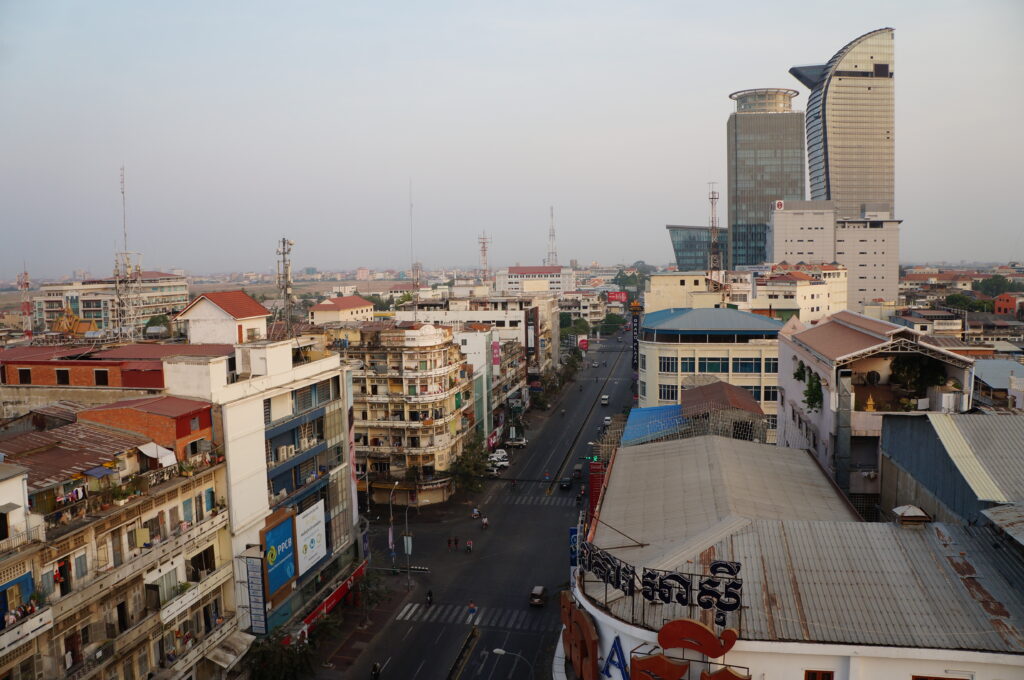ស្ថិរភាពនយោបាយ និងកំណើនសេដ្ឋកិច្ចគ្រប់វិស័យបានដើរតួនាទីយ៉ាងសំខាន់ក្នុងការកសាងទំនុកចិត្តរបស់វិនិយោគិនសាធារណៈ និងបរទេស ហើយក៏បានរក្សាសុវត្ថិភាព និងភាពរឹងមាំនៃប្រព័ន្ធធនាគារនៅកម្ពុជាផងដែរ។ ជាក់ស្តែង វិស័យធនាគារនៅតែបន្តមានកំណើនគួរឱ្យកត់សម្គាល់ ដោយសារវាមានចំណែក ៨២,២% នៅក្នុងទ្រព្យសកម្មសរុបនៃប្រព័ន្ធធនាគារនៅកម្ពុជា។ ទ្រព្យសកម្មសរុបរបស់ធនាគារកើនឡើង ២១,៥ % ស្មើនឹង ១៧២,១ ពាន់ពាន់លានរៀល ឬ (៤២,២ ពាន់លានដុល្លារអាមេរិក) ដែលជាលទ្ធផលនៃប្រាក់បញ្ញើរបស់អតិថិជន និងការខ្ចីមូលនិធិ។1
ចាប់ផ្តើមក្នុងឆ្នាំ ១៩៩៩ រដ្ឋាភិបាលកម្ពុជាបានអនុវត្តបទប្បញ្ញត្តិធនាគារដើម្បីកែលំអទីតាំងពាណិជ្ជកម្មដោយពង្រឹងមូលដ្ឋានគ្រឹះស្ថានហិរញ្ញវត្ថុ និងផ្តល់ភាពងាយស្រួលនៃការផ្តល់ហិរញ្ញប្បទានដល់វិនិយោគិន។ វិស័យធនាគារត្រូវបានគ្រប់គ្រងដោយច្បាប់ដែលមានលក្ខណៈទំនើបបើប្រៀបធៀបទៅនឹងផ្នែកហិរញ្ញវត្ថុផ្សេងទៀត។ តាមរយៈធនាគារជាតិនៃកម្ពុជា ការផ្តល់ប្រាក់កម្ចីឆ្លងកាត់ព្រំដែនត្រូវមានជាឯកសារជាភាសាអង់គ្លេស និងត្រូវបានគ្រប់គ្រងដោយច្បាប់ដែលអនុវត្តក្នុងដែនសមត្ថកិច្ចនីមួយៗ។ ធនាគារមួយចំនួននៅកម្ពុជាបានទទួលយកហិរញ្ញវត្ថុដែលមានការប្រាក់ទាបពីប្រទេសដទៃទៀត ដើម្បីជួយសម្រួលដល់ការផ្តល់ប្រាក់កម្ចីនៅក្នុងស្រុក ដែលជាហេតុនាំឱ្យបំណុលបរទេសកើនឡើង។ ឧទាហរណ៍ក្នុងឆ្នាំ ២០១២ ទ្រព្យសកម្មបរទេសបានធ្លាក់ចុះដោយសារបំណុលបរទេសកើនឡើង។2 ធនាគារជាតិនៃកម្ពុជាដើរតួយ៉ាងសកម្មក្នុងការគ្រប់គ្រង និងសម្របសម្រួលស្ថិរភាពសារពើពន្ធដើម្បីកែលម្អភាពត្រឹមត្រូវ និងប្រសិទ្ធភាពនៃវិស័យហិរញ្ញវត្ថុនេះ ព្រមទាំងបង្កើតអន្តរធនាគារ និងលើកកម្ពស់ទីផ្សារបរទេស។

រូបភាពទេសភាពនៃអគារធនាគារកាណាឌីយ៉ា និងធនាគារវឌ្ឍនៈ។ រូបថត ដោយលោក Pierre André, ថតនៅថ្ងៃទី ០១ ខែកុម្ភះ ឆ្នាំ២០១៤។ ក្រោមអាជ្ញាប័ណ្ណ CC BY-SA 4.0.
យ៉ាងណាម៉ិញ ការកើនឡើងនៃចំនួនធនាគារនេះបណ្តាលឱ្យចំនួនធនាគារហួសកម្រិត។ ការរីកសាយយ៉ាងលឿននៃស្ថាប័នហិរញ្ញវត្ថុ គួបផ្សំនឹងការធ្វើពិពិធកម្មធុរកិច្ច និងសមត្ថភាពត្រួតពិនិត្យនៅមានកម្រិត បង្កការគំរាមកំហែងដល់ស្ថិរភាពហិរញ្ញវត្ថុ។ ម្យ៉ាងវិញទៀត ស្ថិរភាពហិរញ្ញវត្ថុរបស់ប្រទេសក៏អាចរងផលប៉ះពាល់ផងដែរនៅពេលដែលការប្រកួតប្រជែងកើនឡើង។ ដូច្នេះគោលនយោបាយសេវាកម្មហិរញ្ញវត្ថុ និងធនាគារព្រមទាំងបទប្បញ្ញត្តិហិរញ្ញវត្ថុផ្សេងទៀត គឺចាំបាច់ដើម្បីធានាឱ្យបាននូវតុល្យភាព និងនិរន្តរភាពនៃវិស័យធនាគារនៅកម្ពុជាក៏ ដូចជាការពង្រឹងសមត្ថភាពរបស់ខ្លួនក្នុងការទប់ទល់នឹងវិបត្តិសេដ្ឋកិច្ចផងដែរ។
ច្បាប់ស្តីពីគ្រឹះស្ថានធនាគារ និងហិរញ្ញវត្ថុ
ច្បាប់ស្តីពីគ្រឹះស្ថានធនាគារ និងហិរញ្ញវត្ថុដែលបានអនុម័តក្នុងឆ្នាំ ១៩៩៩ បានកំណត់ដើមទុនបម្រុងអប្បបរមាសម្រាប់ធនាគារប្រមាណ ១២,៥ លានដុល្លារ ខណៈធនាគារជាតិនៃកម្ពុជារក្សាទុក ៥% ជាប្រាក់បញ្ញើធានា។ ទោះជាយ៉ាងណា ដើមទុនអប្បបរមាត្រូវបានកែប្រែនៅឆ្នាំ ២០០៨ បន្ទាប់ពីនោះមក ធនាគារពាណិជ្ជកម្មក្នុងស្រុកដែលមានភាគទុនិក ដែលមានឥទ្ធិពលយ៉ាងហោចណាស់មួយរូប ហើយត្រូវបានគេវាយតម្លៃក្នុងថ្នាក់វិនិយោគ ត្រូវបានតម្រូវមានដើមទុនអប្បបរមា ១២,៥ លានដុល្លារ។ ប៉ុន្តែធនាគារពាណិជ្ជកម្មដែលមានបុគ្គល ឬក្រុមហ៊ុនដែលជាម្ចាស់ភាគហ៊ុនរួមគ្នាត្រូវតែមានចំនួនដើមទុនអប្បបរមា ១៥០ ពាន់លានរៀល។ ចំពោះធនាគារឯកទេសដែលត្រូវបានវាយតម្លៃក្នុងថ្នាក់វិនិយោគ និងធនាគារណាដែលមានក្រុមហ៊ុន ឬបុគ្គលជាម្ចាស់ភាគហ៊ុនតម្រូវឱ្យមានដើមទុន ២,៥ លានដុល្លារ និង ៧,៥ លានដុល្លាររៀងៗខ្លួន។3 ក្នុងឆ្នាំ ២០០៨ ធនាគារជាតិនៃកម្ពុជាក៏បានបង្កើនទុនបម្រុងដើមទុនរហូតដល់ ៧៥ លានដុល្លារសម្រាប់ធនាគារពាណិជ្ជកម្ម និង ១៥ លានដុល្លារ សម្រាប់ធនាគារឯកទេស។ ទ្រនាប់ដើមទុនក៏កំពុងត្រូវបានកំណត់ជាមធ្យោបាយមួយដើម្បីធានានិរន្តរភាពនៃស្ថាប័នធនាគារ និងហិរញ្ញវត្ថុនៅកម្ពុជា។4
ទន្ទឹមនឹងនេះដែរ ឧស្សាហកម្មធនាគារនៅកម្ពុជាកំពុងធ្វើសេរីភាវូបនីយកម្មអត្រាការប្រាក់លើប្រាក់បញ្ញើ និងប្រាក់កម្ចី។ ទើបតែនៅក្នុងឆ្នាំ ២០១៧ និងបន្ទាប់ពីមានការព្រួយបារម្ភពីអតិថិជនប្រើប្រាស់ ដែលធ្វើឱ្យធនាគារជាតិនៃកម្ពុជាបានបង្កើតបទប្បញ្ញត្តិពិដានអត្រាការប្រាក់ឥណទានជាក់លាក់មួយ។ បន្ទាប់ពីពេលនោះមក ធនាគារនីមួយៗអាចកំណត់អត្រាការប្រាក់ផ្ទាល់ខ្លួនបាន។5 ស្ថិតក្រោមការត្រួតពិនិត្យបទបញ្ញត្តិ អនុវិស័យហិរញ្ញវត្ថុនីមួយៗមាននីតិកម្ម និងបទប្បញ្ញត្តិជាក់លាក់របស់ខ្លួនដោយធនាគារជាតិនៃកម្ពុជាទទួលខុសត្រូវលើការគ្រប់គ្រង និងការការពារអ្នកប្រើប្រាស់។ ដូច្នោះហើយការបង្កើតបទប្បញ្ញត្តិពិដានអត្រាការប្រាក់ឥណទានបាននាំឱ្យមានការបង្កើតអត្រាការប្រាក់ប្រចាំឆ្នាំអតិបរមា ១៨% សម្រាប់គ្រឹះស្ថានមីក្រូហិរញ្ញវត្ថុ (MFIs) និងស្ថាប័នទទួលយកប្រាក់កម្ចីមីក្រូហិរញ្ញវត្ថុ (MDIs)។
បទប្បញ្ញត្តិមួយផ្សេងទៀតនៃសេវាកម្មធនាគារ និងហិរញ្ញវត្ថុ គឺបទប្បញ្ញត្តិនៃការថយចុះតម្លៃនៃទ្រព្យសកម្ម ដែលត្រូវបានបង្កើតឡើងជាក្របខ័ណ្ឌគ្រប់គ្រងហានិភ័យឥណទានតឹងរឹងជាងមុន និងបានដាក់ចេញនូវលក្ខន្តិក:ថ្មីៗទាក់ទងនឹងការចាត់ថ្នាក់ និងការគណនាប្រាក់កម្ចី។6 មុនពេលអនុវត្តបទប្បញ្ញត្តិស្តីពីការថយចុះតម្លៃនៃទ្រព្យសកម្មនៅចុងឆ្នាំ ២០១៧ វិធានពីរផ្សេងគ្នាត្រូវបានអនុវត្តចំពោះធនាគារឯកទេស និងស្ថាប័នមីក្រូហិរញ្ញវត្ថុ។ បទប្បញ្ញត្តិថ្មីនេះបានធ្វើឱ្យប្រសើរឡើង និងធ្វើឱ្យមានភាពស៊ីគ្នានៃដំណើរការចំណាត់ថ្នាក់នៃប្រាក់កម្ចីនៅគ្រប់ស្ថាប័នហិរញ្ញវត្ថុទាំងអស់របស់ប្រទេសកម្ពុជា និងបានផ្តល់នូវធាតុបន្ថែមសម្រាប់ការពិចារណាក្នុងការបែងចែកប្រភេទនៃប្រាក់កម្ចីដូចជាប្រាក់កម្ចីធម្មតា និងក្រោមកម្រិតដែលត្រូវការ។ បទប្បញ្ញត្តិស្តីពីការថយចុះតម្លៃនៃទ្រព្យសកម្មក៏មានសារៈសំខាន់ផងដែរចំពោះធនាគារនៅពេលរៀបចំរចនាសម្ព័ន្ធឡើងវិញ ឬផ្តល់ប្រាក់កម្ចីឡើងវិញដោយពិចារណាលើកាលៈទេសៈដែលណែនាំលើការរៀបចំរចនាសម្ព័ន្ធឡើងវិញ។7 ធនាគារជាតិនៃកម្ពុជាបានចេញសារាចរមួយផ្សេងទៀតនៅក្នុងខែកុម្ភះ ឆ្នាំ២០១៨ ដែលបានដាក់ចេញនូវតម្រូវការជាក់លាក់ដូចជាការដាក់របាយការណ៍ហិរញ្ញវត្ថុ ការត្រួតពិនិត្យ និងការធ្វើចំណាត់ថ្នាក់ស្ថាប័នហិរញ្ញវត្ថុ និងការកែប្រែគោលនយោបាយឥណទាន។
តម្រូវការប្រាក់បម្រុងកាតព្វកិច្ចសម្រាប់ធនាគារ និងគ្រឹះស្ថានហិរញ្ញវត្ថុ
តម្រូវការប្រាក់បម្រុងទុកកាតព្វកិច្ចក៏ជាឧបករណ៍គោលនយោបាយរូបិយវត្ថុដ៏សំខាន់មួយនៅក្នុងប្រទេសកម្ពុជាផងដែរ។ ធនាគារជាតិនៃកម្ពុជាដាក់លក្ខខណ្ឌប្រាក់បម្រុងកាតព្វកិច្ចសម្រាប់ធនាគារ និងគ្រឹះស្ថានហិរញ្ញវត្ថុ ដែលអាចគ្រប់គ្រង និងការពារសាច់ប្រាក់របស់អ្នកដាក់ប្រាក់បញ្ញើ។ សព្វថ្ងៃនេះមានភាពខុសគ្នានៃអត្រាតម្រូវការប្រាក់បម្រុងកាតព្វកិច្ចរវាងរូបិយប័ណ្ណបរទេស (ជាពិសេសដុល្លារអាមេរិក)និងរូបិយប័ណ្ណក្នុងស្រុក។ តួរយ៉ាង អត្រាតម្រូវការប្រាក់បម្រុងកាតព្វកិច្ចជារូបិយប័ណ្ណបរទេសត្រូវបានកំណត់ត្រឹម ១២,៥% ខណៈរូបិយប័ណ្ណក្នុងស្រុកត្រូវបានកំណត់ត្រឹម ៨%។ ប្រាក់បម្រុងកាតព្វកិច្ចជារូបិយប័ណ្ណបរទេសត្រូវបានផ្តល់ជូននូវអត្រាការប្រាក់ ៤,៥% ដោយធនាគារជាតិនៃកម្ពុជា ខណៈចំនួនដែលនៅសល់ ៨% មិនទទួលបានអត្រាការប្រាក់។ ម្យ៉ាងវិញទៀត មិនមានការផ្តល់ជូនជាអត្រាការប្រាក់ឡើយ សម្រាប់ប្រាក់បម្រុងកាតព្វកិច្ចជារូបិយប័ណ្ណជាប្រាក់រៀល។8
ការផ្លាស់ប្តូររូបិយប័ណ្ណបរទេសទៅលើទំហំអនុបាតតម្រូវការតម្កល់ប្រាក់បម្រុងកាតព្វកិច្ច មិនបានប៉ះពាល់ដល់ប្រតិបត្តិការផ្តល់ប្រាក់កម្ចីរបស់ធនាគារទេ ដោយសារតែប្រាក់បម្រុងមានច្រើនដែលកាន់កាប់ដោយស្ថាប័នផ្តល់ប្រាក់កម្ចី។ អនុបាតតម្រូវការតម្កល់ប្រាក់បម្រុងកាតព្វកិច្ចទៅលើប្រាក់កម្ចីបរទេសត្រូវបានកាត់បន្ថយនៅឆ្នាំ ២០០៨ ដែលជំរុញឱ្យធនាគារ និងស្ថាប័នហិរញ្ញវត្ថុទាក់ទាញលំហូរចូលនៃមូលធន។9 ទោះជាយ៉ាងណាក្តី ខណៈពេលដែលអនុបាតតម្រូវការតម្កល់ប្រាក់បម្រុងកាតព្វកិច្ចលើមូលនិធិបរទេសត្រូវបានកាត់បន្ថយមកត្រឹម ១២% ក្នុងឆ្នាំ ២០០៩ បន្ទាប់មកវាបានកើនឡើងដល់ ១២,៥% វិញក្នុងឆ្នាំ ២០១២។ នៅឆ្នាំ ២០២០ អនុបាតតម្រូវការតម្កល់ប្រាក់បម្រុងកាតព្វកិច្ចលើរូបិយប័ណ្ណអន្តរជាតិ និងក្នុងស្រុកត្រូវបានកាត់បន្ថយមកនៅត្រឹម ៧% បន្ទាប់ពីការរីករាលដាលនៃជំងឺឆ្លងកូវីដ-១៩។10
ស្ថិរភាពនៃអត្រាប្តូរប្រាក់
ធនាគារជាតិនៃកម្ពុជាធ្វើអន្តរាគមន៍ក្នុងទីផ្សារប្តូរប្រាក់បរទេសដើម្បីធ្វើឱ្យអត្រាប្តូរប្រាក់មានស្ថិរភាព។ ជាសេដ្ឋកិច្ចដែលប្រាក់ដុល្លារមានតម្លៃខ្ពស់ សមត្ថភាពរបស់ប្រទេសកម្ពុជាក្នុងការគ្រប់គ្រងអត្រាប្តូរប្រាក់រៀលមានសារៈសំខាន់ណាស់ក្នុងការការពារវិនិយោគិន និងអ្នកចូលរួមផ្សេងទៀតនៅក្នុងទីផ្សារប្តូរប្រាក់បរទេស។11 ធនាគារជាតិនៃកម្ពុជាក៏បានខិតខំរក្សាអត្រាប្តូរប្រាក់ដែលមានចំនួនតម្លៃជិត ៤០០០ រៀលក្នុងមួយដុល្លារចាប់តាំងពីដើមទសវត្សឆ្នាំ ២០០០។
អត្រាប្តូរប្រាក់ថេរនៃប្រាក់រៀលចាប់តាំងពីឆ្នាំ ២០០០ គឺជាកត្តាសំខាន់ក្នុងការកាត់បន្ថយហានិភ័យអត្រាប្តូរប្រាក់របស់វិនិយោគិន ដែលបណ្តាលមកពីអត្រាប្តូរប្រាក់ប្រែប្រួល។ ធនាគារជាតិនៃកម្ពុជាលក់ប្រាក់ដុល្លារអាមេរិកនៅពេលដែលប្រាក់រៀលមានតម្លៃទាបជាងឆ្ងាយពីអត្រាគោលដៅ ដោយហេតុនេះធ្វើឱ្យអត្រាប្តូរប្រាក់មានស្ថិរភាពទោះស្ថិតនៅក្រោមស្ថានភាពរបបអត្រាអណ្តែត។12 ក្រៅពីការពារវិនិយោគិន ការធានាបាននូវអត្រាប្តូរប្រាក់ថេរបានជួយរក្សាលទ្ធភាពទិញរូបិយប័ណ្ណក្នុងស្រុក ក៏ដូចជាគាំទ្រទៅដល់ការពង្រីកសេដ្ឋកិច្ចក្នុងស្រុកផងដែរ។
ប្រធានបទពាក់ព័ន្ធនឹងគោលនយោបាយ និងបទប្បញ្ញត្តិស្តីពីសេវាកម្មធនាគារ និងហិរញ្ញវត្ថុ៖
ឯកសារយោង
- 1. ធនាគារជាតិនៃកម្ពុជា «របាយការណ៍ត្រួតពិនិត្យប្រចាំឆ្នាំ ២០១៩» ថ្ងៃទី ០១ ខែមេសា ឆ្នាំ២០២០។ បានចូលអាននៅថ្ងៃទី ១៥ ខែកញ្ញា ឆ្នាំ២០២០។
- 2. Unteroberdoerster, M. O. «ប្រទេសកម្ពុជា៖ ការឈានចូលដំណាក់កាលថ្មីនៃការលូតលាស់» ឆ្នាំ ២០១៤។ បានចូលអាននៅថ្ងៃទី ១៥ ខែកញ្ញា ឆ្នាំ២០២០។
- 3. Smith, P. «ធនាគារជាតិនៃកម្ពុជាបង្កើនតំរូវការដើមទុនអប្បបរមាសម្រាប់ការចុះបញ្ជីស្ថាប័នហិរញ្ញវត្ថុ» មិនមានថ្ងៃបរិច្ឆេទ។ បានចូលអាននៅថ្ងៃទី ១៥ ខែកញ្ញា ឆ្នាំ២០២០។
- 4. Burn & Associates «ទិដ្ឋភាពទូទៅនៃទីផ្សារធនាគារ និងមូលធននៅកម្ពុជា» ឆ្នាំ ២០២០។ បានចូលអាននៅថ្ងៃទី ១០ ខែកញ្ញា ឆ្នាំ២០២០។
- 5. សាជីវកម្មហិរញ្ញវត្ថុអន្តរជាតិ (IFC) «លើកកម្ពស់ការការពារអតិថិជនលើវិស័យហិរញ្ញវត្ថុនៅកម្ពុជា» ឆ្នាំ ២០១៥។ បានចូលអាននៅថ្ងៃទី ១៥ ខែកញ្ញា ឆ្នាំ២០២០។
- 6. Khou, V., Cheng, O., Leng, S., & Meng, C. «តួនាទីរបស់ធនាគារកណ្តាលក្នុងការគាំទ្រដល់ការធ្វើពិពិធកម្មសេដ្ឋកិច្ច និងផលិតភាពការងារនៅកម្ពុជា» ឆ្នាំ ២០១៥។ បានចូលអាននៅថ្ងៃទី ១៥ ខែកញ្ញា ឆ្នាំ២០២០។
- 7. ដូចឯកសារយោងខាងដើម។
- 8. ធនាគារជាតិនៃកម្ពុជា «របាយការណ៍ត្រួតពិនិត្យប្រចាំឆ្នាំ ២០១៩» ថ្ងៃទី ០១ ខែមេសា ឆ្នាំ២០២០។ បានចូលអាននៅថ្ងៃទី ១៥ ខែកញ្ញា ឆ្នាំ២០២០។
- 9. ដូចឯកសារយោងខាងដើម។
- 10. ធនាគារពិភពលោក «បច្ចុប្បន្នភាពសេដ្ឋកិច្ចកម្ពុជា៖ កម្ពុជាក្នុងបរិការណ៍នៃជំងឺកូវីដ-១៩» ខែឧសភា ឆ្នាំ ២០២០។ បានចូលអាននៅថ្ងៃទី ១៥ ខែកញ្ញា ឆ្នាំ២០២០។
- 11. Unteroberdoerster, M. O. «ប្រទេសកម្ពុជា៖ ការឈានចូលដំណាក់កាលថ្មីនៃការលូតលាស់» ឆ្នាំ ២០១៤។ បានចូលអាននៅថ្ងៃទី ១៥ ខែកញ្ញា ឆ្នាំ២០២០។
- 12. Khou, V., Cheng, O., Leng, S., & Meng, C. «តួនាទីរបស់ធនាគារកណ្តាលក្នុងការគាំទ្រដល់ការធ្វើពិពិធកម្មសេដ្ឋកិច្ច និងផលិតភាពការងារនៅកម្ពុជា» ឆ្នាំ ២០១៥។ បានចូលអាននៅថ្ងៃទី ១៥ ខែកញ្ញា ឆ្នាំ២០២០។

